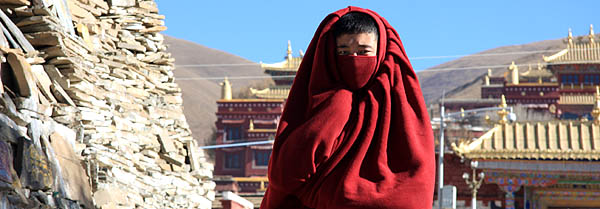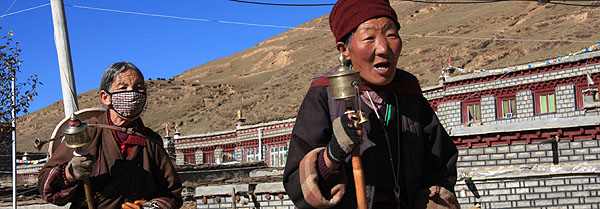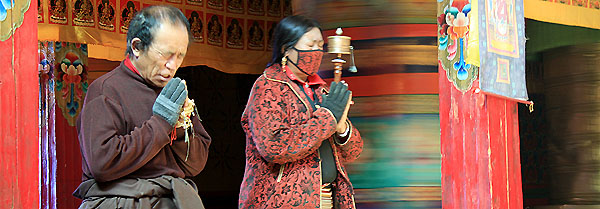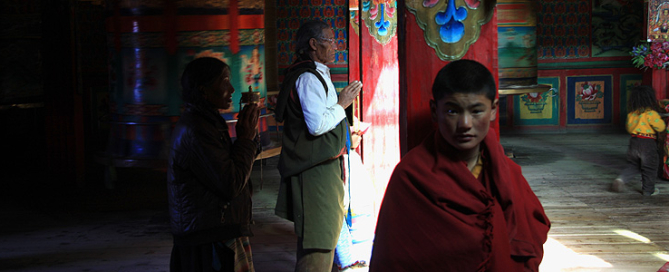When I arrived to Litang I stopped few days to rest and fix the bike. I also visited its monastery which date from the XVI century and I was interested about Tibetan Buddhism together to one of its oldest traditions: the sky burial.
“A Buddha is not a God, neither a messiah, nor a prophet”, said to me a monk. The Buddhism is a religion no-theistic. In general, the Buddhists neither think nor speculate on the existence or not of God or a Supreme Creator. The Buddhism doesn’t require of this resource to explain how to reach the illumination. Buddha is considered like the guide and the teacher who points the way out to reach the nirvana; he is not a deity which people have to adore. The philosophy and meditative practice of the Buddhist system were not a divine revelation, but rather the understanding of the true nature of the mind and such an understanding can be discovered by anyone.
Litang is known as the birthplace of the seventh and tenth Dalai Lama, and in its monastery live more than a hundred monks who have the function of maintaining ritual practices and teachings of Tibetan Buddhism. To do this monks and younger monks are engaged in study the main texts of Sutras which are the teachings given by Buddha or some of his closer disciples.

According to Dorjee, a monk I met at the monastery, Buddhism entered Tibet in the VIII century by the Indian guru Padmasambhava. But in the olden days, due to the difficult geography of the place, for being distant, monasteries had little contact with each other. So it emerged a variety of schools, doctrines and practices. Thus the Tibetan Buddhism was born, which is based on his lineage when legitimize their teachings, ie, that have been transmitted from teacher to disciple from the time of Buddha and always has been made of pure form, by fully understanding. Nowadays Tibetan Buddhism is the majority religion in Mongolia and Bhutan and it is also present in Nepal, northern India, China and Russia. And it is one of the most famous Buddhist schools and practiced in the West in which everyone recognizes the Dalai Lama as their spiritual leader.
On the way to the monastery I crossed nearly a hundred faithful who came from the close neighborhoods spinning their manikors. The manikor or wheel of prayers is a small revolving cylinder which traditionally is used for the prayer. It is believed that each rotation is equal to an expression of the mantra OM MANI PADME HUM, the mantra of the compassion which is inscribed inside and outside of the manikor.

According people explained me the mantra helps to achieve the perfection in the practice of the generosity, of the pure ethic, of the tolerance and of the wisdom. In this way the faithful were heading to the stupa or shrine, to walk around while still spinning their prayer wheels and chanting mantras. Then they entered the small temple in front of the monastery to do their prayers, some were thrown to the floor while others seemed to cling to the prayer. It was moving, I spent a long time there and I returned the next day. I was struck by the devotion with which they did.

The last day of my stay in Litang I was interested to know about the sky burial or Tianzang, an ancient funerary tradition of Tibetan Buddhism. Thereby I went to the outskirts of the city. According to the tradition, when someone dies, he is covered with a white cloth and brought him to a valley. There his family hand the body to the Tondem, the master of ceremony who remove the white cloth and chop the body into pieces with a knife. Then it is offered to the vultures. In this way the birds can tear the flesh and devour it. After the responsible of ceremony cut into pieces the body with an ax and grind it, mixing it with barley flour so the wind do the rest. Witnessing this ritual was creepy; at times I had to move away due to the strong odor or shocks that it caused me. According to Buddhist belief, the body is a vehicle that transports a person throughout life. When someone dies, his soul separates from the body which has already fulfilled its function. “Feeding with the own body to the vultures is a final act of generosity toward the living world, and creates a link with the cycle of life”, Dorjee explained me.[:]


